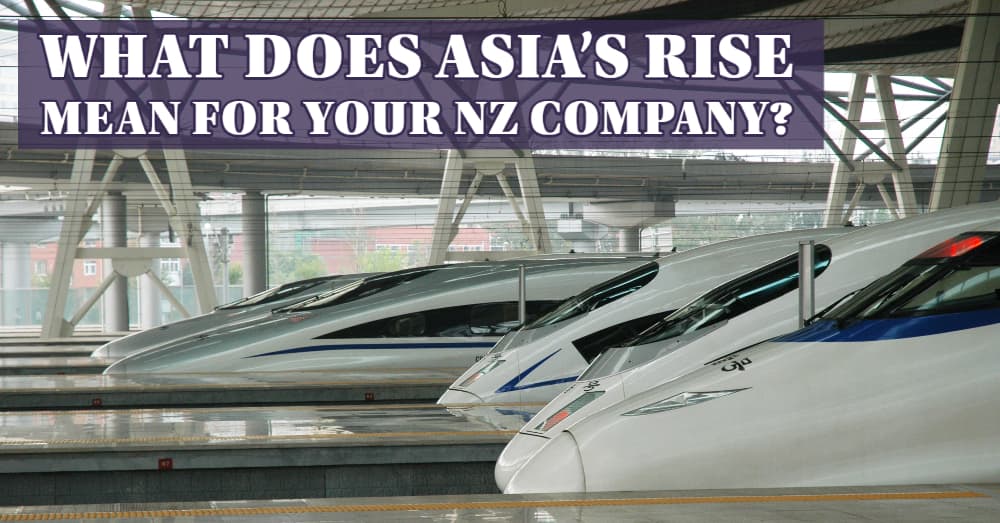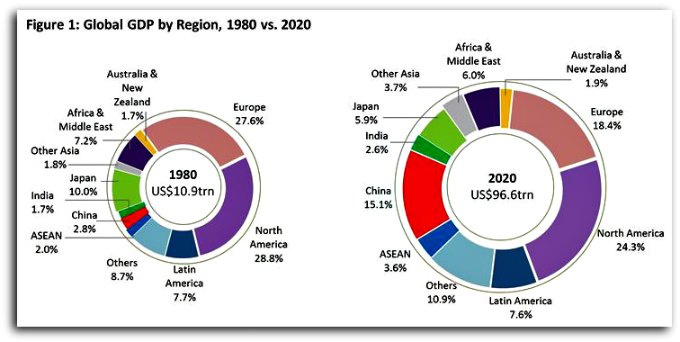
What does Asia’s Rise Mean for Your NZ Company?
3-minute read
The IMF (International Monetary Fund) data indicate a continued rise in the proportion of the global GDP accounted for by Asia. The Asian region almost doubles in importance in the 40-year period to 2020, rising from 18.3 percent of the global economy in 1980 to 30.8 percent in 2020.
Meanwhile, Europe shrinks in relative size from 27.6 percent of global GDP to 18.4 percent; North America, Japan and the Middle East and Africa all register sharp declines. Globally, the growth gap continues to widen — in favour of the emerging markets (see Figure 1).

*Other Asia includes Korea, Taiwan, Hong Kong, Mongolia, Sri Lanka, Pakistan, Bangladesh, Nepal
In the period from 1980 to 2020, ASEAN as a grouping is projected to grow its share of global GDP, nearly doubling its percentage share in the 40-year period.
Among the world’s major economies and regional blocs, this achievement is second only to that of China.
The implication is straightforward: international marketers will reallocate resources to address the opportunity such that global sales by region are more closely aligned with global GDP by region.
This creates both and opportunity and a threat for New Zealand exporters.
Within the context of the Government’s Business Growth Agenda to raise exports from 30 percent to 40 percent of GDP, New Zealand needs to raise its export performance not just in terms of volume of trade but also value.
If we sit back and ride the wave of population and consumption growth in Asia we run the risk of being locked into another cycle of predominantly commodity-driven export growth.
What’s in It for You?
If we look back in 10 years, at 7 percent annual compound growth and a doubling of export trade with Asia we may congratulate ourselves, but we will have missed the value curve and left money on the table.
New Zealand has many advantages in this region that makes trading easier than our competitors in Europe or the US.
- Geographic proximity – most markets are accessible within 1-2 plane rides and 12 hours of travel or less.
- Political closeness – New Zealand is generally accepted as a trusted partner and not an agent with independent political agendas. We are often seen as having technology and governance structures of merit and use to trade partners.
- Time zone efficiency – business can be transacted in New Zealand time zones.
While obvious, these factors significantly reduce the cost of doing business and present advantages to our SME’s wishing to export to Asia.
The looming advent of the Trans Pacific Partnership (TPP) free trade agreement will see 50 percent of the world’s trade covered in one free trade agreement.
The agreement will reduce tariffs and enable simpler cross border transfer of goods. It will deliver significant opportunities to New Zealand Exporters, but this will also open them up to new competitors.
The winners in this competition will be companies that evolve their business models from exporters to in-market players. These are companies that import, process, value-add and market to their customers.
They become in effect supply chain managers that source in the lowest cost market, process in the lowest cost market and sell in the highest cost market taking advantage of efficiencies in freight logistics, labour and tax while optimising their business to take advantage of regional free trade agreements.
Question: How does Asian region’s growth affect you? Leave your comments below.
P.S. Easy Freight Ltd helps New Zealand importers & exporters to save money on international freight and reduce mistakes by guiding how to comply with Customs and biosecurity rules.
➔ Contact us now to learn how we can assist you.
